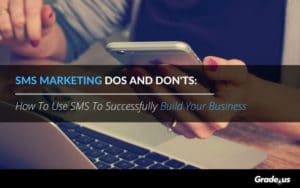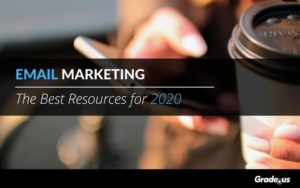Nancy Harhut knows how to get into your head.
She only uses her powers for awesome, of course. She delivers actionable insights to brands who need to stand out in a saturated marketplace, and she gets results. Need content or copy that really speaks to our most basic, most primal decision-making mechanisms? Nancy’s the woman to call.
She does it through the power of behavioral science, which she’s been studying for years. She’s the expert the experts call, and shares her ideas at conferences around the world.
It was an honor to get to sit down with her, and she was quite happy to share a little bit of advice about how you can increase conversions and response rates by getting into the heads of your own customers.
Getting started with behavioral science and learning to apply it to marketing
Raney: If someone’s just getting started with using behavioral science in marketing, where do you recommend they begin? What’s the most high-impact way to start making adjustments?
Nancy: Start by thinking about your target. You want to think about the target market, think about the product, think about the competitors.
Then, hypothesize why it is that people don’t want to do what you want them to do.
Obviously, as a marketer, you want them to take an action. Start thinking on the reasons why someone might not want to take that action.
Then you can start to think about the behavioral science triggers you can possibly use to get people to overcome those buying barriers, and you can test them. You might identify three or four different behavioral science principles that might work well against the barrier.
For example, if the barrier is price, the assumption is we want people to make this purchase, but they think the price is too high.
You might want to try testing something like social proof, where someone who is like the intended target says something like, “I thought the price was a little expensive, but then I actually tried the product, and it’s worth every penny.”
When you see something like that, you think: oh, okay. They had the same concern I did. They rolled the dice, they took the risk, and they were pleased, so maybe I can do that too.
Or maybe you think the best way to go up against price would be to invoke the Authority Principle. Maybe you say, “Hey, this is recommended by the American Dental Association.” They’re an authority in the field, therefore you can trust them, therefore it makes sense to pay the higher price because you’re going to get a quality product.
You could try the Scarcity Principle, and say: “We’re the only ones who offer these particular features.”
Then the buyer might think: okay, it’s going to cost me a little bit more than it would if I went with a competitor, but I’m going to get things I wouldn’t get someplace else.
Try one. Test and refine. That’s where you’re really going to make the biggest impact out of the gate if you want to use behavioral science.
Psychological principals that you can apply to your marketing
Raney: What are some of the other principles marketers can use?
Nancy: There are literally hundreds of them. I think social scientists and behavioral economists have identified hundreds of these decision-making shortcuts that we as people rely on, whether it’s a B2B situation or a B2C situation.
The idea is we’re so bombarded with information we couldn’t possibly weigh every bit of data before making a decision, and if we did, we just wouldn’t get around to making any decisions.
So, over the millennia, human beings have developed these hard-wired behaviors that we just default to when we encounter certain situations.
From a marketing perspective, there are a group of them that seem to be particularly applicable in terms of getting people to take action. Social Proof works because when we’re not certain what decision to make we look to other people and follow their lead. It’s a herd mentality.
The Authority Principle works because when we were children we were taught to recognize and respect authority figures. By the time we’re adults that behavior is ingrained in us. If an authority tells us to do something, we generally do it, and if an authority tells us something, we generally believe it.
The Scarcity Principle works because we as human beings are just hardwired to place greater value on things that are scarce. Things that aren’t available to everybody, are only available in limited qualities, or for limited times.
There are probably another dozen or so I myself use most often when developing work for my clients because they just seem to really work well and appeal to the decision-making shortcuts humans use when making buying decisions.
Applying psychological principles to branding
Raney: What are some of the ways companies could integrate behavioral science, not just in their marketing collateral, but into their branding efforts as well?
Nancy: You want people to notice your brand. You want to get people to remember your brand. You want them to think of your brand favorably.
There are a few ways you could use behavioral science to answer those needs.
One would be something known as the “Rhyme is Reason” principle. We have a tendency to believe phrases that rhyme more than phrases than phrases that don’t rhyme. Humans think a phrase is more truthful and accurate if it rhymes because it’s easy for the human brain to process. As a result, it just feels better. It feels right.
Think about tag lines like, “Nationwide is on your side.”
Raney: Versus, “Nationwide really cares about you.”
Nancy: People are going to have an easier time remembering it and believing it. You can use that when developing tag lines, headlines, or subheads in your content marketing or in your ads.
Another thing you can do when you’re trying to tap into behavioral science for brand building efforts is to think about the psychology of surprise.
The human brain is hardwired to predict what comes next. If you change that, you surprise someone. When people are surprised, a couple of things happen. It focuses their attention. It intensifies their emotions by about 400%.
Both of those make it more likely you’re going to remember what’s just surprised you. So, do something in your branding campaign that’s going to surprise people. Lead them to believe one thing is going to happen and then give them another thing.
Another thing is something known as the Von Restorff Effect. Social scientists have found humans are hardwired to notice and remember things that are different. I think as marketers we kind of know that intuitively, which is why we try to make things stand out.
I just got back from Reykjavik in Iceland.
One of the things I wanted to do there was to try to see the Northern Lights. I was looking at all of my options. There were several different bus tours, and there were a couple of different boat tours.
Pretty much to a company they said, “Hey, look, we stay on top of the weather and if it doesn’t look like you’re going to be able to see the Northern Lights, we’ll cancel the tour. There’s no sense in dragging you out when you could be doing something else if there’s not a good chance you’re going to see the Northern Lights.”
Then there was this one company.
What they said was, “Listen. We go the extra mile. We will go out every time we’ve scheduled a tour, and the reason we do this is we know you’re here for a limited amount of time. We also know the weather in Iceland changes on a whim. So, we’re going to take you out and put you in the best position to see the Northern Lights should they appear.”
It was a really interesting way of framing their story and making it different than everybody else.
Raney: Did you go on the tour?
Nancy: I did go on the tour, and we saw pale Northern Lights. They weren’t the picture-perfect ones you see in the brochures, but it was pretty cool. But we saw something, and the night before we’d seen nothing, so I was psyched. I was happy to have seen it.
If you think about the competitors and you think about the target market, knowing everyone is going for the same people, you have to make your offering a little bit different.
Raney: Anything else on branding?
Nancy: Incorporate storytelling. I know, “storytelling, “has become a buzzword these days. But for good reason.
Stories are engaging. They’re involving. They’re how information has been passed down from generation to generation before the written word even existed.
Storytelling also has an interesting impact on the brain.
If we’re only dealing with facts and figures, Broca’s area and Wernicke’s area. Those are the two areas of the brain responsible for processing language.
If you’re watching a story or listening to a story, other parts of your brain get activated. If part of your story involves how something smells, like the scent of freshly brewed coffee, that’s going to activate the olfactory cortex in your brain.
If part of the story involves action: running, jumping, punching, flying, any kind of motor activity…it activates the motor cortex.
If the story involves the feel of soft buttery leather, that activates the sensory cortex.
The more parts of your brain that are activated, the better you understand the information and the longer you retain it. So fold storytelling and the behavioral science around it into your brand-building efforts.
Psychologically influenced conversion tactics
Raney: Let’s talk about conversions for a minute. What are people’s primary emotional barriers to purchasing a new product, not just the logical ones like price? How do you bring down those barriers?
Nancy: I think it probably varies by product and by target market. There may be different barriers.
I think one that cuts across a lot of products and a lot of target markets is fear.
Nobody wants to take any risks. Nobody wants to make a mistake. You don’t want to spend money you’re unhappy you spent, or buy a product you’re unhappy you own. Loss aversion is very powerful. We feel losses twice as powerfully as we feel gains.
If we were in Vegas and we were playing a slot machine and won $100, on a scale of 1-10 that might feel like a 5. If we lost the same $100, it wouldn’t feel like -5. It would feel like -10.
Because we feel losses so powerfully we’re always trying to guard against them.
Anything you can do to make people feel more comfortable and confident about making a purchase will help you make that conversion.
There are a few different ways to remove fear.
You can offer a guarantee. Guarantees are great because they remove risks.
You can use social proof. If people like them have purchased this product or service and have been pleased, you’ll be pleased too. Of course, the secret there is to make sure the quotes or the testimonials or the rankings you’re featuring are very similar to the target you’re trying to convince, because the closer that person is to the person making the purchase decision the more relevant that information will be.
Free trials remove risk. People think: well, if I’m unhappy I can just return it and I’m not losing anything.
Raney: People have to consciously know some of those tactics. For example, I know prices ending in “9” perform better. I think a lot of people know that. So why do these things work? Why don’t we ever stop and go, “Well, objectively this is $4.77 and this is $5.99 so I’m going to buy the one that’s $4.77?”
Nancy: This takes us back to the idea that there’s so much data coming at us, so much information that we don’t have time to think about and evaluate each fact before making decisions.
As a result, we’ve developed “decision defaults.”
That’s not to say at any given moment someone might not have their thinking cap on.
With your thinking cap on, you might be thinking, “Ok. I’m weighing the pros and cons here. I’m doing a very active, in-the-moment comparison. I’m really thinking about this, I’m doing the cost-benefit analysis. This is crazy. I’m not going to buy the one that’s $5.99, I’m going to buy the one that’s $4.77.”
So often, we don’t have our thinking caps on.
We’re not in the moment. We’re not really concentrating and making active decisions where we’re weighing the pros and cons or doing the cost-benefit analysis to come up with the absolute best answer.
We’re distracted. We’re cruising along on autopilot. As a result, those decision defaults kick in.
We don’t really have the time to be in the moment and to think rationally about every decision we have to make. So we have to prioritize. Some decisions really get that high-level cognitive scrutiny.
Others? We “satisfice.” It’s good enough. It may not be the absolute best, but it’s good enough. We’re just kind of trying to get through the day.
Raney: There are contradictions too. One thing that’s always baffled me is: statistics tell us most people barely read anything. They’ve got this 3-second goldfish attention span. But then we look at other statistics, and they say long form content of 1200+ words performs the best. What’s going on here?
Nancy: I do believe people have short attention spans. I believe people are skimming and scanning.
And yet, I see on the flip side the proof points saying longer articles have the higher clickthrough rates.
I believe when something does capture our attention, and it interests us, we can just consume, consume, consume.
I think the key is really to target your message very well. Go deep on what you know your target market is going to want to find out. If you’re interested in the subject you’ll keep reading. You’ll keep scrolling. You’ll keep researching and gathering more information.
If we provide the value, information, or entertainment someone wants, they’ll stay longer. We need to be quick, short, and succinct, but once we hook somebody they’re willing to go deep.
The mis-use of behavioral science in marketing
Raney: Last question. What can go wrong when people start trying to use behavioral science in their marketing?
Nancy: There are two things that can go wrong.
One is you read a book or an article, or listen to a conference session, and you think: “Wow, this is really cool. I get it. I get how this works.”
You go off and think you can do it, and what you’re not really factoring in is whoever gave the conference session or wrote the book did it based on years of study, research, and testing. A lot of work came before the book or conference session that made it sound so easy and interesting.
A little bit of information doesn’t mean you can do this. You need to dig into it and study it.
I would recommend you find a partner who has some experience using behavioral science. Try not to do it all on your own, especially when you’re starting out.
The second place things can go wrong is when something puts something out there in the market, and it doesn’t get the response you’re looking for. Then you say, “Okay, well, clearly these behavioral science techniques don’t work for me.” Or for our product, our service, or our company.
The truth is there’s no silver bullet. If you don’t get the response you wanted, try something else. What works for someone else might not work for you. What works for you might not work for the other person. What worked a year ago may not work now.
You can’t make someone do something they’re not going to want to do. Even if they’re on the fence, the behavioral science can nudge you in one direction or the other, you’re never going to get a 100% conversion rate. If we could, there’d be some of us that would be happily retired right now! We could go out and look for the Northern Lights every night if we wanted to!
Want to keep learning more about behavioral science? Follow Nancy at @nharhut on Twitter, or catch her at the 2020 Content Marketing Conference in Boston, MA on April 21 through the 23rd.











